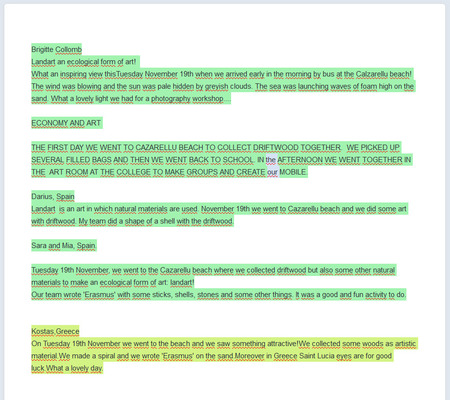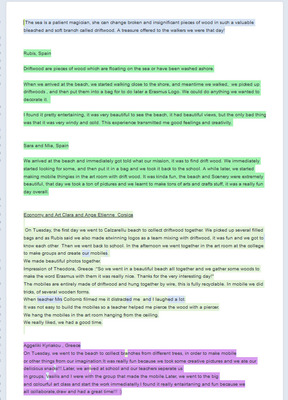1. Cultural Heritage (legacy of physical)
Artifacts and intangible attributes of a group or society that is inherited from past generations: includes architecture, art, objects, music, legends, recipes, festivals, typical jobs, flags, history...)
(http://)
www.unesco.org/new/en/culture/themes/illicit-trafficking-of-cultural-property/unesco-database-of-national-cultural-heritage-laws/frequently-asked-questions/definition-of-the-cultural-heritage/
Colour: Brown
ARTICLE 1: The Legend of ST Lucie's eyes. (Corsican students will type it directly in the magazine + pictures as we read it on the beach)
ARTICLE 2: Ecology and art: Landart at the seaside or in the forest!
(Définition of landart, our landart during the mobility from the legend to the Landart and photos , free pictures of landart you have done or you can find on the net?)
http://annuel2.framapad.org/p/9f95-landartarticlewriting
COPY OF THE FRAMAPAD:

ARTICLE 3: Ecology and art: From driftwood picking to mobile building.
(Narrative, interview, definition of driftwood, another form of ecological art)
http://annuel2.framapad.org/p/9f95-driftwoodmobilebuilding
COPY OF THE FRAMAPAD:

ARTICLE 4: 4 European dances! Body clapping. Dancing in pairs and gender equity.
Being a dance teacher and a choreographer.
(Each country could tell about its dance and music, definition of ecological body clapping, the importance to dance in pairs boy and girl, your likes, opinions, would you like to be a dance teacher? A dancer? A choreographer?)
TWINBOARD
ARTICLE 5: 4 European desserts and cooking with a professional cook.
( Share your recipes, share about your cooking workshop for those who participated in, which was your favourite dessert? Would you like to become a cook? )
DISCUSSION